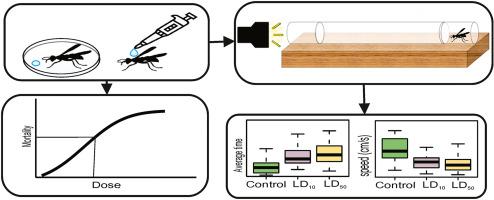Environmental Pollution ( IF 7.6 ) Pub Date : 2022-06-24 , DOI: 10.1016/j.envpol.2022.119682 Nathan Rodrigues Batista 1 , Vinicius Edson Soares de Oliveira 2 , Paula Danyelle Crispim 3 , Roberta Cornélio Ferreira Nocelli 4 , William Fernando Antonialli-Junior 5

|
Neonicotinoids are among the chemicals most widely used against insects considered agricultural pests, although they may also affect nontarget species, as has been reported for social bees. Social wasps are recognized as efficient predators of larvae of other insects, including pest species, so they may have contact with insecticides, at least indirectly. However, to date, there have been no studies investigating the consequences for social wasps of the use of neonicotinoids. Therefore, the aim of this study was to obtain the topical and oral acute lethal mean doses of the neonicotinoid thiamethoxam, as well as to evaluate the effects of sublethal contamination, for the social wasp Polybia paulista. Foraging wasps were exposed orally and topically, with monitoring of their mortality after 24 and 48 h, in order to calculate the LD50 values. Other wasps were then exposed with sublethal doses, in order to evaluate the effects of contamination on their mobility. The results indicated that P. paulista workers are as sensitive to thiamethoxam contamination as several nontarget species studied previously. Exposure to a sublethal dose (LD10) negatively affected their mobility. It could be concluded that social wasp colonies may be as much affected by exposure to neonicotinoids as social bees. Further toxicological studies should be conducted, evaluating other parameters and different species, in order to understand the extent of the problems faced by these insects due to the use of neonicotinoids.
中文翻译:

社交黄蜂 Polybia paulista 是新烟碱类污染的沉默受害者吗?
新烟碱类是最广泛用于对抗被认为是农业害虫的昆虫的化学物质之一,尽管它们也可能影响非目标物种,如社会蜜蜂所报道的那样。社会黄蜂被认为是其他昆虫(包括害虫)幼虫的有效捕食者,因此它们可能至少间接接触杀虫剂。然而,迄今为止,还没有研究调查使用新烟碱对社会黄蜂的影响。因此,本研究的目的是获得新烟碱类噻虫嗪的局部和口服急性致死平均剂量,并评估亚致死污染对社会黄蜂Polybia paulista的影响. 觅食黄蜂被口服和局部暴露,在 24 和 48 小时后监测它们的死亡率,以计算 LD 50值。然后将其他黄蜂暴露在亚致死剂量下,以评估污染对其活动性的影响。结果表明P. paulista工人对噻虫嗪污染的敏感性与先前研究的几种非目标物种一样敏感。暴露于亚致死剂量(LD 10) 对他们的流动性产生了负面影响。可以得出结论,社会黄蜂群落可能与社会蜜蜂一样受到新烟碱类物质的影响。应进行进一步的毒理学研究,评估其他参数和不同物种,以了解这些昆虫因使用新烟碱类而面临的问题的程度。











































 京公网安备 11010802027423号
京公网安备 11010802027423号